The opening of the tomb of Tutankhamon! Now see those moments in COLOR!

Advertisement
Egyptian pharaoh Tutankhamun acceded to the throne and assumed his divine role when he was just 9 years of age and died nine years later when he was 18 years old.
The discovery of his tomb has gone down in history because it is one of the few burials of ancient Egypt that has arrived intact and untouched to us, thanks to the discovery of the archaeologist Howard Carter in 1922.
At the time, on hand to document everything was photographer Harry Burton, and now, for the first time, it is possible to revisit those moments in color thanks to a digital painting process (photo colorization) invented by the English company Dynamichrome.
The funeral mask of Tutankhamen

Advertisement
Howard Carter, Lord Carnarvon, and an Egyptian worker as they open the sanctuary.

The carved ceremonial bed, which was in the tomb, is in the form of the goddess Hathor and is surrounded by valuable objects.

A partial view of the antechamber shows a bed with gold lions, chests, two sentries, colored wood, and gold.

Boat models from that epoch

Advertisement
Two ceremonial beds and other objects that belonged to Tutankhamun when he was still alive.

Chests and chairs made of ebony and ivory

Advertisement
A bust of the goddess Hathor, a golden chest, and canopic jars containing the internal organs of the pharaoh.

The same containers as seen from another photographic perspective.

Advertisement
Carved alabaster jars

An ad hoc laboratory set up in the tomb of Seti II, where Arthur Mace and Alfred Lucas cleaned the statues.

Advertisement
Howard Carter, Arthur Callender, and an Egyptian worker prepare one of the statues to be transported.

Arthur Mace and Alfred Lucas work on a golden chariot near the tomb of Seti II.

Advertisement
The God Anubis depicted as jackal in the treasure room in the tomb.

Carter, Callende, and two Egyptian workers remove the wall between the anteroom and the burial chamber.

Advertisement
In the first external sanctuary, a huge linen cloth with bronze rosettes was found

Carter, Mace, and an Egyptian worker as they carefully wrap the linen cloth that covered the second sanctuary.

Carter, Callender and two Egyptian workers dismantle one of the golden shrines in the burial chamber.

Howard Carter in front of the sarcophagus and ready to start analyzing it.

Carter and a worker examine the inner coffin which was made of pure gold.

And ... here is Lord Carnarvon, who completely financed the excavation (without him we probably would not have these sensational photos).

Advertisement





